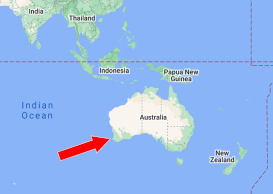We came across this brand of lump charcoal on Amazon and thought it would be interesting to try some "fruitwood" charcoal
from Australia.
As usual, we include a map at right for your convenience.

First of all, we need to talk about how the charcoal was shipped to us.
We don't usually have a lot to say about
the shipping, but in this case the lack of care in packaging warrants a comment.
Here's a photo of how
charcoal was packaged. No padding and placed in a box far too large for the bag, allowing the bag
to tumble around on its way to us.
And here's a photo of some of the resulting damage.
So we were not expecting the best when we dumped the charcoal out on the ground for sorting and inspection, and we
didn't get the best. As you can see in the following table, 23.2% of the bag was comprised of chips and dust. How bad
is that? It places Saruma charcoal in the worst five brands ever in terms of weight of chips and dust. Think about it.
You'll probably be tossing almost a quarter of the bag. While the remaining contents of the bag were a nice mix of
large, medium and small pieces (including some rather large logs), still you are having to throw away nearly 25% of
an already expensive charcoal. Needless to say, the amount of chips and dust is Very High compared to other brands.
| Large |
3.2 pounds |
29.5% |
| Medium |
3.0 pounds |
28.2% |
| Small |
2.1 pounds |
19.1% |
| Chips/Dust |
2.5 pounds |
23.2% |
|
|
|
| Total |
10.8 pounds |
|
|
The next thing we'll point out is that the bag was nearly a quarter pound underweight. We
ordered two bags, one was split open as we showed you, but the second bag was intact and it
was underweight. So, you're throwing away nearly a quarter of the bag and to boot, you don't
even get the advertised amount of charcoal.
And one final observation before we look at how the charcoal performs, we did find several
small strips of plastic in the charcoal. These strips come from plastic woven fabrics used in
making bags and tarps.
Next, in our lighting test in which we see how many sheets of newspaper it takes to get a fire
going in a standard chimney starter, Saruma charcoal was very easy to light. It took only 2
sheets of newspaper to get the fire going, which is Very Low compared to other brands.
While the charcoal was starting, there was some
moderate popping and a small amount of sparking. The smell of the smoke was moderate and
pleasant. At the same time, if you inhaled enough it was quite biting.
In our maximum temperature test, Saruma burned at 853°F which is only Average compared
to other brands. While the charcoal was coming up to temperature there was a small amount
of sparking and popping. The fire spread quite rapidly and took little time to hit its
maximum temperature.
Saruma charcoal burned a fairly long time in our burn time test, ranking High compared to other
brands. Lighting with a MAP/Pro torch produced little sparking but some fairly significant pops.
As always, exercise caution when using any sort of torch to light lump charcoal.
Finally, the amount of ash produced was quite high, ranking it Very High compared to other
brands.
So, what rating does Saruma charcoal get? Although it burned a reasonably long time and was
very easy to light, Saruma charcoal only reaches an Average maximum temperature, contains an
enormous amount of chips and dust and produces an enormous volume of ash. Add to that the fact
that the charcoal is poorly packaged for shipping and the bags don't contain the advertised
weight of charcoal, we can only give this brand our second lowest rating, Below Average.

